Carbon Storage Potential of Silvopastoral Systems of Colombia
Abstract
:1. Introduction
2. Methods
2.1. Conceptual Approach
2.2. Study Area
2.3. Data Collection and Analysis
3. Results
3.1. Estimates of Tree Cover on Grassland in 2000, 2008, and 2017
3.2. Biomass Carbon Stocks
3.3. Carbon Stock Gaps by Ecofloristic Zones
4. Discussion
5. Conclusions
Author Contributions
Funding
Conflicts of Interest
References
- Wollenberg, E.; Richards, M.; Smith, P.; Havlík, P.; Obersteiner, M.; Tubiello, F.N.; Herold, M.; Gerber, P.; Carter, S.; Reisinger, A.; et al. Reducing emissions from agriculture to meet the 2 °C target. Glob. Chang. Biol. 2016, 22, 3859–3864. [Google Scholar] [CrossRef] [PubMed] [Green Version]
- Smith, P. Soil carbon sequestration and biochar as negative emission technologies. Glob. Chang. Biol. 2016, 22, 1315–1324. [Google Scholar] [CrossRef]
- Roe, S.; Streck, C.; Obersteiner, M.; Frank, S.; Griscom, B.; Drouet, L.; Fricko, O.; Gusti, M.; Harris, N.; Hasegawa, T.; et al. Contribution of the land sector to a 1.5 °C world. Nat. Clim. Chang. 2019, 9, 817–828. [Google Scholar] [CrossRef]
- Witkowski, K.; Medina, D. Agriculture in the New Climate Action Plans of Latin America (Intended Nationally Determined Contributions); Inter-American Institute for Cooperation on Agriculture: San Jose, Costa Rica, 2016. [Google Scholar]
- Griscom, B.W.; Adams, J.; Ellis, P.W.; Houghton, R.A.; Lomax, G.; Miteva, D.A.; Schlesinger, W.H.; Shoch, D.; Siikamäki, J.V.; Smith, P.; et al. Natural climate solutions. Proc. Natl. Acad. Sci. USA 2017, 114, 11645–11650. [Google Scholar] [CrossRef] [PubMed] [Green Version]
- IPCC. Climate Change and Land: An IPCC Special Report on Climate Change, Desertification, Land Degradation, Sustainable Land Management, Food Security, and Greenhouse Gas Fluxes in Terrestrial Ecosystems; Shukla, P.R., Skea, J., Buendia, E.C., Masson-Delmotte, V., Pörtner, H.-O., Roberts, D.C., Zhai, P., Slade, R., Connors, S., van Diemen, R., et al., Eds.; IPCC: Geneva, Switzerland, 2019. [Google Scholar]
- Cardona, C.A.C.; Naranjo Ramiírez, J.F.; Tarazona Morales, A.M.; Murgueitio Restrepo, E.; Charaá Orozco, J.D.; Ku Vera, J.; Solorio Saánchez, F.J.; Flores Estrada, M.X.; Solorio Saánchez, B.; Barahona Rosales, R. Contribution of intensive silvopastoral systems to animal performance and to adaptation and mitigation of climate change. Rev. Colomb. Cienc. Pecu. 2014, 27, 76–94. [Google Scholar]
- Calle, Z.; Murgueitio, E.; Chará, J.; Molina, C.H.; Zuluaga, A.F.; Calle, A. A Strategy for Scaling-Up Intensive Silvopastoral Systems in Colombia. J. Sustain. For. 2013, 32, 677–693. [Google Scholar]
- Van Dijk, S.; Tennigkeit, T.; Wilkes, A. Climate-Smart Livestock Sector Development: The State of Play in NAMA Development; CGIAR Research Program on Climate Change, Agriculture and Food Security (CCAFS): Copenhagen, Denmark, 2015. [Google Scholar]
- Cardinael, R.; Umulisa, V.; Toudert, A.; Olivier, A.; Bockel, L.; Bernoux, M. Revisiting IPCC Tier 1 coefficients for soil organic and biomass carbon storage in agroforestry systems. Environ. Res. Lett. 2018, 13, 12. [Google Scholar] [CrossRef]
- Zomer, R.; Trabucco, A.; Coe, R.; Place, F.; van Noordwijk, M.; Xu, J. Trees on Farms: An Update and Reanalysis of Agroforestry’s Global Extent and Socio-Ecological Characteristics; World Agroforestry Centre (ICRAF): Bogor, Indonesia, 2014. [Google Scholar]
- Zomer, R.J.; Neufeldt, H.; Xu, J.; Ahrends, A.; Bossio, D.; Trabucco, A.; Van Noordwijk, M.; Wang, M. Global Tree Cover and Biomass Carbon on Agricultural Land: The contribution of agroforestry to global and national carbon budgets. Sci. Rep. 2016, 6, 29987. [Google Scholar] [CrossRef]
- Rosenstock, T.S.; Wilkes, A.; Jallo, C.; Namoi, N.; Bulusu, M.; Suber, M.; Mboi, D.; Mulia, R.; Simelton, E.; Richards, M.; et al. Making trees count: Measurement and reporting of agroforestry in UNFCCC national communications of non-Annex I countries. Agric. Ecosyst. Environ. 2019, 284, 106569. [Google Scholar] [CrossRef]
- FEDEGAN. Cifras de Referencia del Sector Ganadero Colombiano; FEDEGAN Federacioún Colombiana de Ganaderos: Bogota, Colombia, 2018. [Google Scholar]
- Tapasco, J.; LeCoq, J.F.; Ruden, A.; Rivas, J.S.; Ortiz, J. The Livestock Sector in Colombia: Toward a Program to Facilitate Large-Scale Adoption of Mitigation and Adaptation Practices. Front. Sustain. Food Syst. 2019, 3, 61. [Google Scholar] [CrossRef] [Green Version]
- Lerner, A.M.; Zuluaga, A.F.; Chará, J.; Etter, A.; Searchinger, T. Sustainable Cattle Ranching in Practice: Moving from Theory to Planning in Colombia’s Livestock Sector. Environ. Manag. 2017, 60, 176–184. [Google Scholar] [CrossRef] [PubMed]
- ESA. Land Cover CCI: Product User Guide Version 2.0; UCL-Geomatics: London, UK, 2017. [Google Scholar]
- Dimiceli, C.; Carroll, M.; Sohlberg, R.; Kim, D.H.; Kelly, M.; Townshend, J.R.G. MOD44B MODIS/Terra Vegetation Continuous Fields Yearly L3 Global 250m SIN Grid V006; LP DAAC: Sioux Falls, SD, USA, 2020. [Google Scholar]
- Ruesch, A.; Gibbs, H.K. New IPCC Tier-1 Global Biomass Carbon Map For the Year 2000; Oak Ridge National Laboratory: Oak Ridge, YN, USA, 2008. [Google Scholar]
- Heiskanen, J.; Liu, J.; Valbuena, R.; Aynekulu, E.; Packalen, P.; Pellikka, P. Remote sensing approach for spatial planning of land management interventions in West African savannas. J. Arid Environ. 2017, 140, 29–41. [Google Scholar] [CrossRef] [Green Version]
- Sánchez-Cuervo, A.M.; Aide, T.M.; Clark, M.L.; Etter, A. Land Cover Change in Colombia: Surprising Forest Recovery Trends between 2001 and 2010. PLoS ONE 2012, 7, e43943. [Google Scholar] [CrossRef] [Green Version]
- Fagua, J.C.; Baggio, J.A.; Ramsey, R.D. Drivers of forest cover changes in the Chocó-Darien Global Ecoregion of South America. Ecosphere 2019, 10, e02648. [Google Scholar] [CrossRef] [Green Version]
- Chapman, M.; Walker, W.S.; Cook-Patton, S.C.; Ellis, P.W.; Farina, M.; Griscom, B.W.; Baccini, A. Large climate mitigation potential from adding trees to agricultural lands. Glob. Chang. Biol. 2020, 26, 4357–4365. [Google Scholar] [CrossRef]
- Liu, Y.Y.; Van Dijk, A.I.J.M.; De Jeu, R.A.M.; Canadell, J.G.; McCabe, M.F.; Evans, J.P.; Wang, G. Recent reversal in loss of global terrestrial biomass. Nat. Clim. Chang. 2015, 5, 470–474. [Google Scholar] [CrossRef]
- Liu, Y.Y.; De Jeu, R.A.M.; McCabe, M.F.; Evans, J.P.; Van Dijk, A.I.J.M. Global long-term passive microwave satellite-based retrievals of vegetation optical depth. Geophys. Res. Lett. 2011, 38. [Google Scholar] [CrossRef] [Green Version]
- Feliciano, D.; Ledo, A.; Hillier, J.; Nayak, D.R. Which agroforestry options give the greatest soil and above ground carbon benefits in different world regions? Agric. Ecosyst. Environ. 2018, 254, 117–129. [Google Scholar] [CrossRef]
- López-Santiago, J.G.; Casanova-Lugo, F.; Villanueva-López, G.; Díaz-Echeverría, V.F.; Solorio-Sánchez, F.J.; Martínez-Zurimendi, P.; Aryal, D.R.; Chay-Canul, A.J. Carbon storage in a silvopastoral system compared to that in a deciduous dry forest in Michoacán, Mexico. Agrofor. Syst. 2019, 93, 199–211. [Google Scholar] [CrossRef]
- ESA. 300 m Annual Global Land Cover Time Series from 1992 to 2015; ESA Climate Change Initiative: Oxford, UK, 2017. [Google Scholar]
- Steiner, J.L.; Franzluebbers, A.J.; Neely, C.; Ellis, T.; Aynekulu, E. Enhancing Soil and Landscape Quality in Smallholder Grazing Systems. In Enhancing Soil and Landscape Quality in Smallholder Grazing Systems; Lal, R., Stewart, B.A., Eds.; CRC Press: Boca Raton, FL, USA, 2014; pp. 63–112. [Google Scholar]
- Montagnini, F.; Ibrahim, M.; Murgueitio Restrepo, E. Silvopastoral Systems and Climate Change Mitigation in Latin America. Bois For. Trop. 2013, 316, 3–16. [Google Scholar] [CrossRef]
- Dinesh, D.; Campbell, B.; Bonilla-Findji, O.; Richards, M. (Eds.) 10 Best Bet Innovations for Adaptation in Agriculture: A Supplement to the UNFCCC NAP Technical Guidelines; CGIAR Research Program on Climate Change, Agriculture and Food Security (CCAFS): Wageningen, The Netherlands, 2017. [Google Scholar]
- Eekhout, J.; de Vente, J. Assessing the effectiveness of Sustainable Land Management for large-scale climate change adaptation. Sci. Total Environ. 2018, 654, 85–93. [Google Scholar] [CrossRef] [PubMed]
- Chara, J.; Reyes, E.; Peri, P.; Otte, J.; Arce, E.; Schneider, F. Silvopastoral Systems and Their Contribution to Improved Resource Use and Sustainable Development Goals: Evidence from Latin America; The Food and Agriculture Organization of the United Nations: Roma, Italy, 2018. [Google Scholar]
- Durr, P.; Gangel, J. Enhanced forage production under Samanea saman in a subhumid tropical grassland. Agrofor. Syst. 2002, 54, 99–102. [Google Scholar] [CrossRef]
- Durr, P. The biology, ecology and agroforestry potential of the raintree, Samanea saman (Jacq.) Merr. Agrofor. Syst. 2001, 51, 223–237. [Google Scholar] [CrossRef]
- Roshetko, J.; Lasco, R.; Delos Angeles, M. Smallholder agroforestry systems for carbon storage. Mitig. Adapt. Strateg. Glob. Chang. 2007, 12, 219–242. [Google Scholar] [CrossRef]
- Calle, A.; Montagnini, F.; Zuluaga, A.F. Farmer’s perceptions of silvopastoral system promotion in Quindío, Colombia. Bois For. Trop. 2009, 300, 79–94. [Google Scholar] [CrossRef]
- Roshetko, J.; Dawson, I.; Urquiola, J.; Lasco, R.; Leimona, B.; Weber, J.; Bozzano, M.; Lillesø, J.; Graudal, L.; Jamnadass, R. To what extent are genetic resources considered in environmental service provision? A case study based on trees and carbon sequestration. Clim. Dev. 2018, 10, 755–768. [Google Scholar] [CrossRef]
- Iiyama, M.; Derero, A.; Kelemu, K.; Muthuri, C.; Kinuthia, R.; Ayenkulu, E.; Kiptot, E.; Hadgu, K.; Mowo, J.; Sinclair, F.L. Understanding patterns of tree adoption on farms in semi-arid and sub-humid Ethiopia. Agrofor. Syst. 2017, 91, 271–293. [Google Scholar] [CrossRef] [Green Version]
- Mbow, C.; Van Noordwijk, M.; Luedeling, E.; Neufeldt, H.; Minang, P.A.; Kowero, G. Agroforestry solutions to address food security and climate change challenges in Africa. Curr. Opin. Environ. Sustain. 2014, 6, 61–67. [Google Scholar] [CrossRef] [Green Version]
- Murgueitio, E.; Calle, Z.; Uribe, F.; Calle, A.; Solorio, B. Native trees and shrubs for the productive rehabilitation of tropical cattle ranching lands. For. Ecol. Manag. 2011, 261, 1654–1663. [Google Scholar] [CrossRef]
- Lohbeck, M.; Winowiecki, L.; Aynekulu, E.; Okia, C.; Vågen, T.G. Trait-based approaches for guiding the restoration of degraded agricultural landscapes in East Africa. J. Appl. Ecol. 2018, 55, 59–68. [Google Scholar] [CrossRef]
- Abreu, R.C.R.; Hoffmann, W.A.; Vasconcelos, H.L.; Pilon, N.A.; Rossatto, D.R.; Durigan, G. The biodiversity cost of carbon sequestration in tropical savanna. Sci. Adv. 2017, 3, e1701284. [Google Scholar] [CrossRef] [PubMed] [Green Version]
- Bond, W.J.; Stevens, N.; Midgley, G.F.; Lehmann, C.E.R. The Trouble with Trees: Afforestation Plans for Africa. Trends Ecol. Evol. 2019, 34, 963–965. [Google Scholar] [CrossRef] [PubMed]
- Parr, C.L.; Gray, E.F.; Bond, W.J. Cascading biodiversity and functional consequences of a global change-induced biome switch. Divers. Distrib. 2012, 18, 493–503. [Google Scholar] [CrossRef]
- Friedlingstein, P.; Allen, M.; Canadell, J.G.; Peters, G.P.; Seneviratne, S.I. Comment on “The global tree restoration potential”. Science 2019, 366, eaay8060. [Google Scholar] [CrossRef] [Green Version]
- Skidmore, A.K.; Wang, W.; de Bie, K.; Pilesjo, P. Comment on “The global tree restoration potential”. Science 2019, 366, eaaz0111. [Google Scholar] [CrossRef] [Green Version]
- Bastin, J.F.; Finegold, Y.; Garcia, C.; Mollicone, D.; Rezende, M.; Routh, D.; Zohner, C.M.; Crowther, T.W. The global tree restoration potential. Science 2019, 364, 76–79. [Google Scholar] [CrossRef]
- Lusiana, B.; van Noordwijk, M.; Johana, F.; Galudra, G.; Suyanto, S.; Cadisch, G. Implications of uncertainty and scale in carbon emission estimates on locally appropriate designs to reduce emissions from deforestation and degradation (REDD+). Mitig. Adapt. Strateg. Glob. Chang. 2014, 19, 757–772. [Google Scholar] [CrossRef] [Green Version]
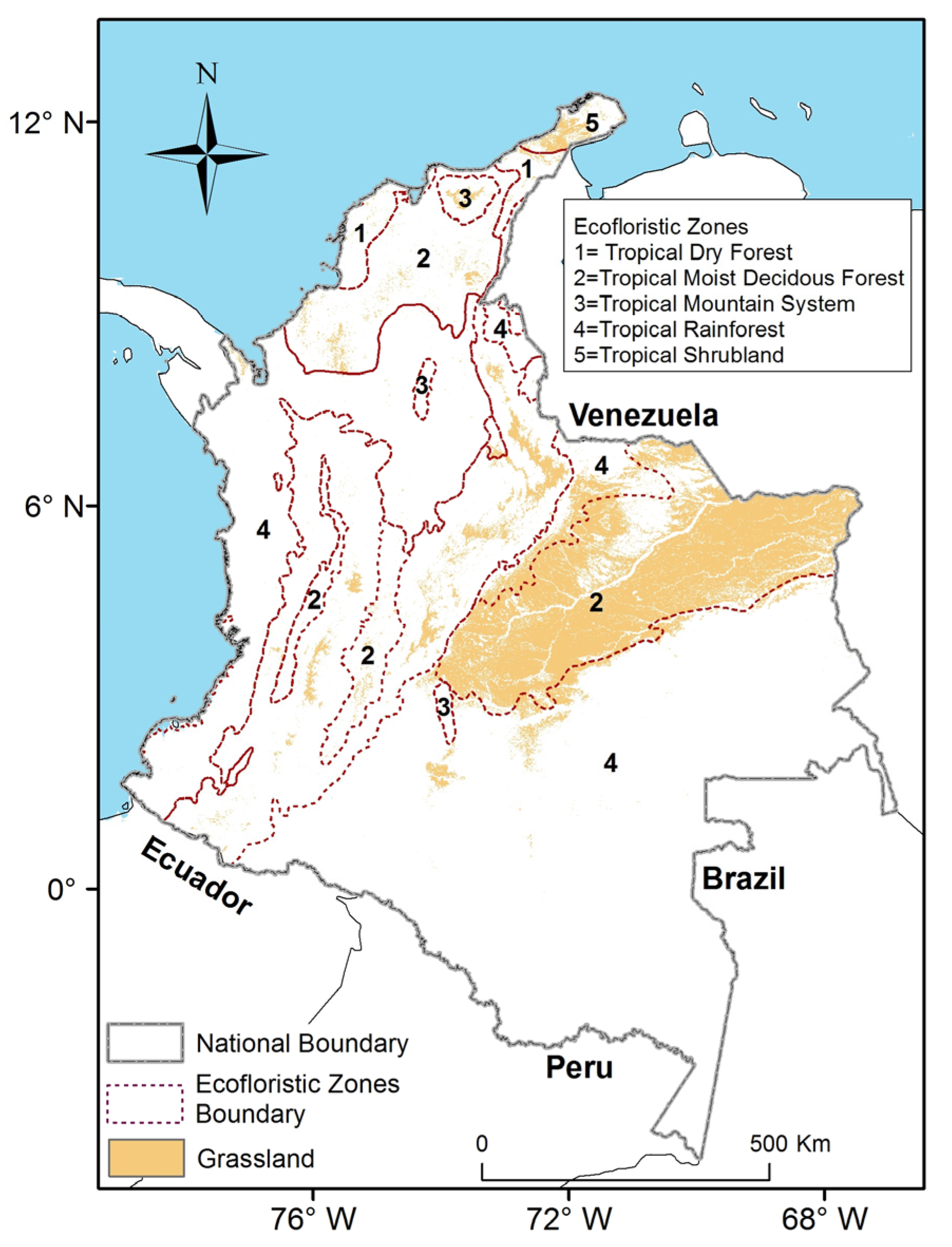
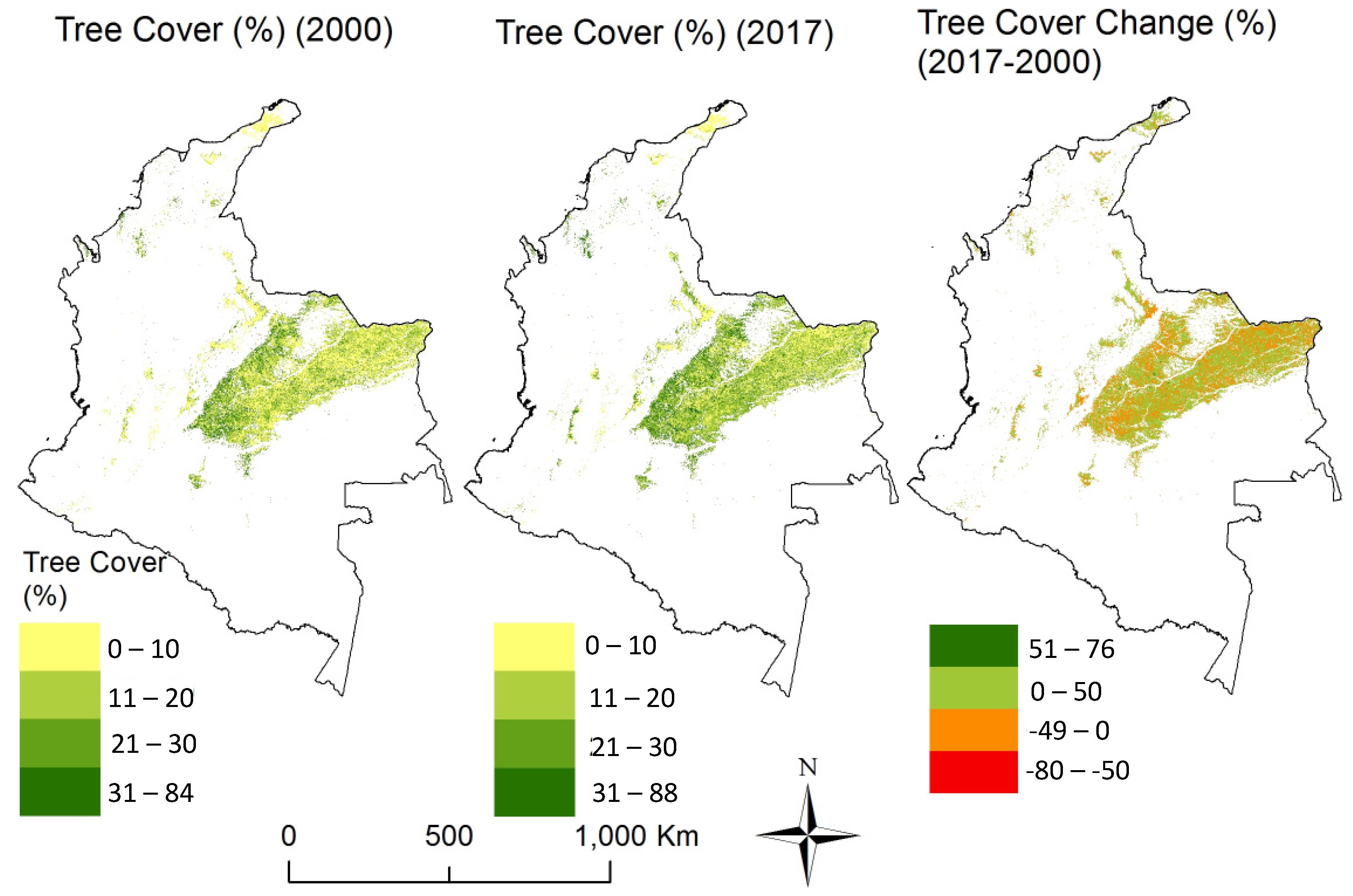
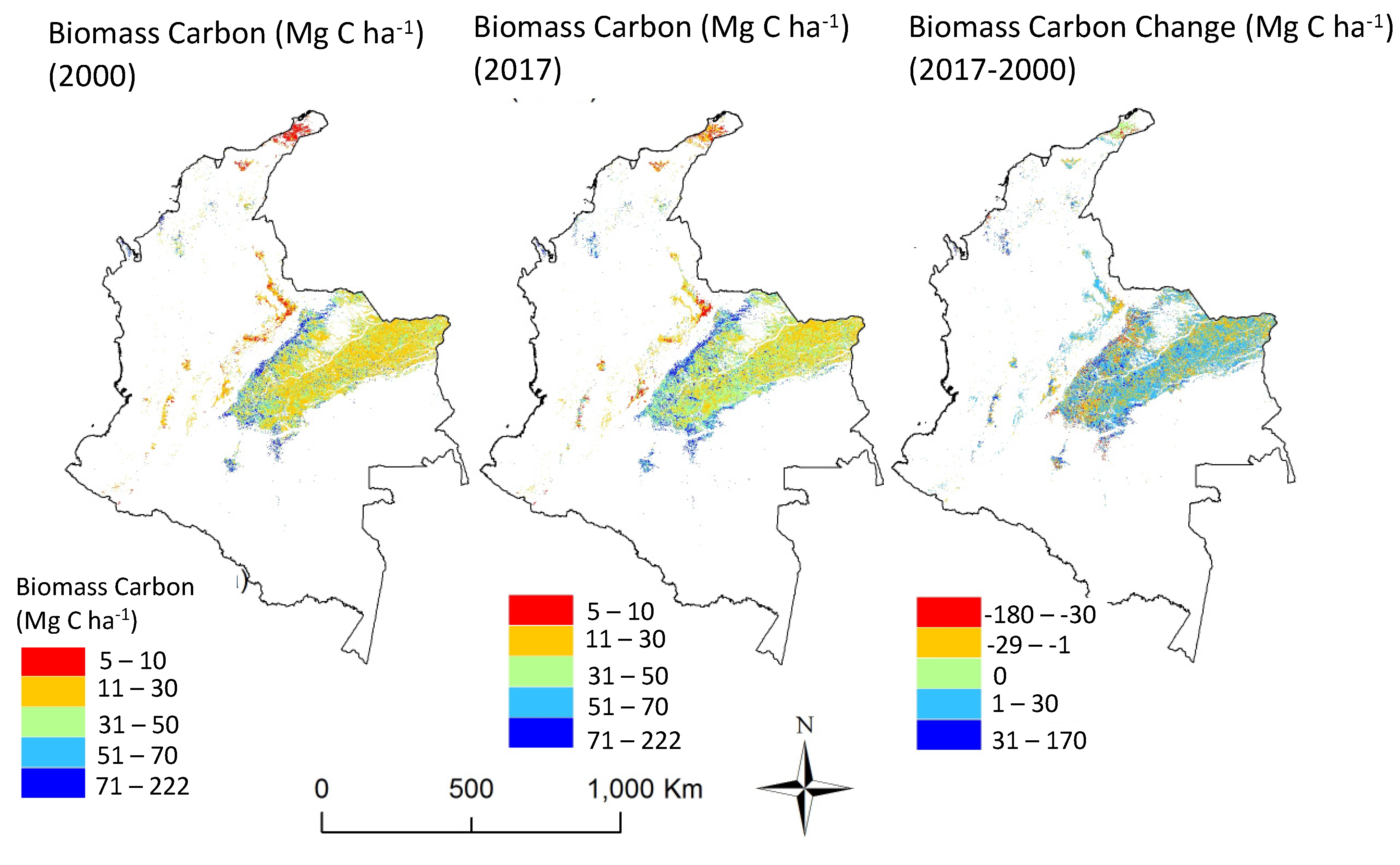
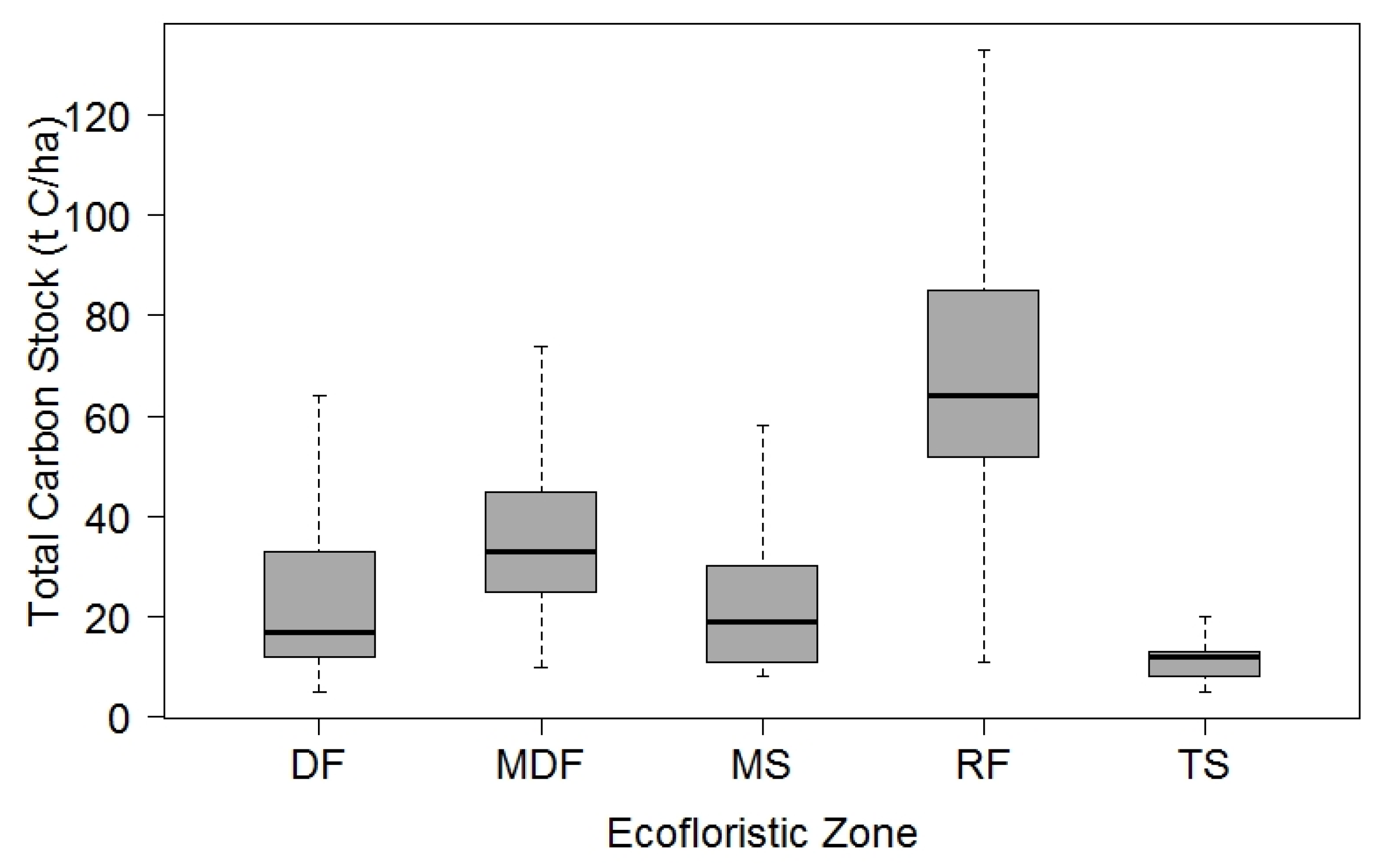
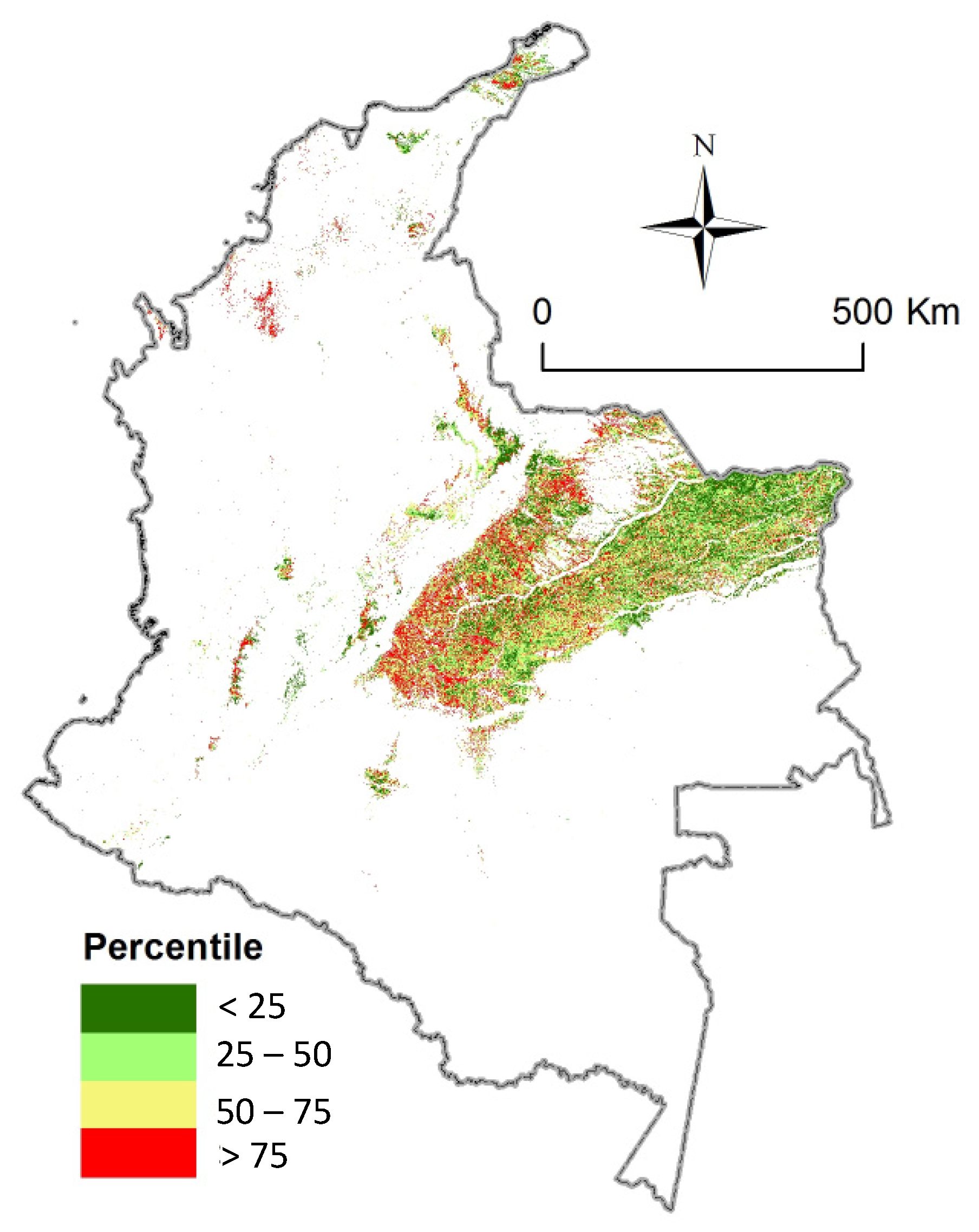
| Ecofloristic Zone | Area | Above Ground Carbon Stocks Mg ha−1 | Root to Shoot Ratio | ||
|---|---|---|---|---|---|
| ha | % | Minimum | Maximum | ||
| Tropical dry forest | 67,758 | 0.6 | 4 | 126 | 0.28 |
| Tropical Moist deciduous forest | 9,487,070 | 77 | 8 | 128 | 0.24 |
| Tropical mountain system | 1,076,967 | 8.8 | 6 | 87 | 0.27 |
| Tropical rainforest | 1,469,597 | 12 | 8 | 193 | 0.37 |
| Tropical shrubland | 206,495 | 1.7 | 4 | 126 | 0.28 |
| Total | 12,307,887 | 100 | |||
| Tree Cover (%) | 2000 | 2008 | 2017 | |||
|---|---|---|---|---|---|---|
| ha | (%) | ha | % | ha | % | |
| ≤10 | 5,507,090 | 45 | 3,210,585 | 26 | 3,319,775 | 27 |
| 11–20 | 3,883,571 | 32 | 4,861,344 | 39 | 4,700,027 | 38 |
| 21–30 | 1,715,737 | 14 | 2,708,461 | 22 | 2,709,611 | 22 |
| >30 | 1,201,488 | 10 | 1,527,496 | 12 | 1,578,474 | 13 |
| Total | 12,307,887 | 100 | 12,307,887 | 100 | 12,307,887 | 100 |
| Biomass Carbon | Average (SD) (Mg ha−1) | Total (Pg C) | ||||
|---|---|---|---|---|---|---|
| 2000 | 2017 | Change | 2000 | 2017 | Change | |
| Above ground | 27 (14) | 31 (14) | 4 | 0.33 | 0.38 | 0.05 |
| Total biomass | 34 (18) | 39 (18) | 5 | 0.41 | 0.48 | 0.07 |
| Total Carbon Stocks (Mg ha−1) | 2000 | 2008 | 2017 | |||
|---|---|---|---|---|---|---|
| ha | % | ha | % | ha | % | |
| ≤10 | 489,333 | 4 | 610,508 | 5 | 355,760 | 3 |
| 11–25 | 4,967,851 | 40 | 2,715,698 | 22 | 3,063,775 | 25 |
| 26–50 | 4,937,931 | 40 | 6,199,358 | 50 | 6,207,735 | 50 |
| 51–75 | 1,185,878 | 10 | 1,968,009 | 16 | 1,796,833 | 15 |
| 76–100 | 514,348 | 4 | 575,421 | 5 | 643,622 | 5 |
| >100 | 212,545 | 2 | 238,892 | 2 | 240,161 | 2 |
| Total | 12,307,887 | 100 | 12,307,887 | 100 | 12,307,887 | 100 |
© 2020 by the authors. Licensee MDPI, Basel, Switzerland. This article is an open access article distributed under the terms and conditions of the Creative Commons Attribution (CC BY) license (http://creativecommons.org/licenses/by/4.0/).
Share and Cite
Aynekulu, E.; Suber, M.; van Noordwijk, M.; Arango, J.; Roshetko, J.M.; Rosenstock, T.S. Carbon Storage Potential of Silvopastoral Systems of Colombia. Land 2020, 9, 309. https://doi.org/10.3390/land9090309
Aynekulu E, Suber M, van Noordwijk M, Arango J, Roshetko JM, Rosenstock TS. Carbon Storage Potential of Silvopastoral Systems of Colombia. Land. 2020; 9(9):309. https://doi.org/10.3390/land9090309
Chicago/Turabian StyleAynekulu, Ermias, Marta Suber, Meine van Noordwijk, Jacobo Arango, James M. Roshetko, and Todd S. Rosenstock. 2020. "Carbon Storage Potential of Silvopastoral Systems of Colombia" Land 9, no. 9: 309. https://doi.org/10.3390/land9090309
APA StyleAynekulu, E., Suber, M., van Noordwijk, M., Arango, J., Roshetko, J. M., & Rosenstock, T. S. (2020). Carbon Storage Potential of Silvopastoral Systems of Colombia. Land, 9(9), 309. https://doi.org/10.3390/land9090309






